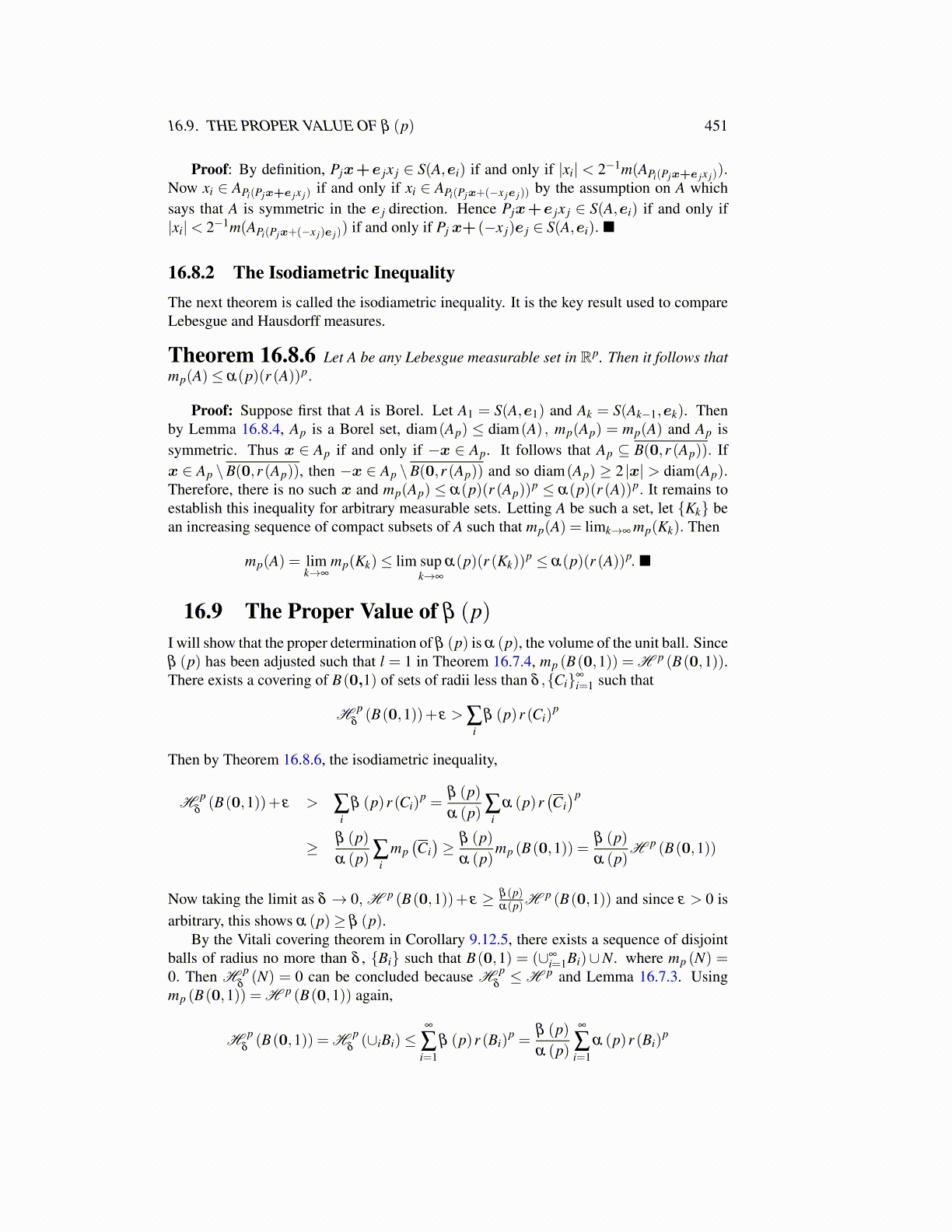
16.9. THE PROPER VALUE OF β (p) 451
Proof: By definition, Pjx+e jx j ∈ S(A,ei) if and only if |xi| < 2−1m(APi(Pjx+e jx j)).Now xi ∈ APi(Pjx+e jx j) if and only if xi ∈ APi(Pjx+(−x je j)) by the assumption on A whichsays that A is symmetric in the e j direction. Hence Pjx+e jx j ∈ S(A,ei) if and only if|xi|< 2−1m(APi(Pjx+(−x j)e j)) if and only if Pj x+ (−x j)e j ∈ S(A,ei). ■
16.8.2 The Isodiametric InequalityThe next theorem is called the isodiametric inequality. It is the key result used to compareLebesgue and Hausdorff measures.
Theorem 16.8.6 Let A be any Lebesgue measurable set in Rp. Then it follows thatmp(A)≤ α(p)(r (A))p.
Proof: Suppose first that A is Borel. Let A1 = S(A,e1) and Ak = S(Ak−1,ek). Thenby Lemma 16.8.4, Ap is a Borel set, diam(Ap) ≤ diam(A) , mp(Ap) = mp(A) and Ap issymmetric. Thus x ∈ Ap if and only if −x ∈ Ap. It follows that Ap ⊆ B(0,r (Ap)). Ifx ∈ Ap \B(0,r (Ap)), then −x ∈ Ap \B(0,r (Ap)) and so diam(Ap) ≥ 2 |x| > diam(Ap).Therefore, there is no such x and mp(Ap) ≤ α(p)(r (Ap))
p ≤ α(p)(r (A))p. It remains toestablish this inequality for arbitrary measurable sets. Letting A be such a set, let {Kk} bean increasing sequence of compact subsets of A such that mp(A) = limk→∞ mp(Kk). Then
mp(A) = limk→∞
mp(Kk)≤ lim supk→∞
α(p)(r (Kk))p ≤ α(p)(r (A))p. ■
16.9 The Proper Value of β (p)I will show that the proper determination of β (p) is α (p), the volume of the unit ball. Sinceβ (p) has been adjusted such that l = 1 in Theorem 16.7.4, mp (B(0,1)) = H p (B(0,1)).There exists a covering of B(0,1) of sets of radii less than δ ,{Ci}∞
i=1 such that
H pδ(B(0,1))+ ε > ∑
iβ (p)r (Ci)
p
Then by Theorem 16.8.6, the isodiametric inequality,
H pδ(B(0,1))+ ε > ∑
iβ (p)r (Ci)
p =β (p)α (p) ∑
iα (p)r
(Ci)p
≥ β (p)α (p) ∑
imp(Ci)≥ β (p)
α (p)mp (B(0,1)) =
β (p)α (p)
H p (B(0,1))
Now taking the limit as δ → 0, H p (B(0,1))+ ε ≥ β (p)α(p)H
p (B(0,1)) and since ε > 0 isarbitrary, this shows α (p)≥ β (p).
By the Vitali covering theorem in Corollary 9.12.5, there exists a sequence of disjointballs of radius no more than δ , {Bi} such that B(0,1) = (∪∞
i=1Bi)∪N. where mp (N) =0. Then H p
δ(N) = 0 can be concluded because H p
δ≤H p and Lemma 16.7.3. Using
mp (B(0,1)) = H p (B(0,1)) again,
H pδ(B(0,1)) = H p
δ(∪iBi)≤
∞
∑i=1
β (p)r (Bi)p =
β (p)α (p)
∞
∑i=1
α (p)r (Bi)p